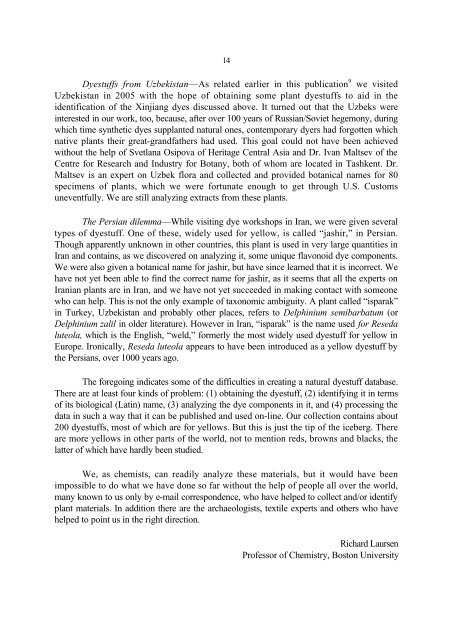download - OATG. Oxford Asian Textile Group
download - OATG. Oxford Asian Textile Group
download - OATG. Oxford Asian Textile Group
- No tags were found...
You also want an ePaper? Increase the reach of your titles
YUMPU automatically turns print PDFs into web optimized ePapers that Google loves.
14Dyestuffs from Uzbekistan—As related earlier in this publication 9 we visitedUzbekistan in 2005 with the hope of obtaining some plant dyestuffs to aid in theidentification of the Xinjiang dyes discussed above. It turned out that the Uzbeks wereinterested in our work, too, because, after over 100 years of Russian/Soviet hegemony, duringwhich time synthetic dyes supplanted natural ones, contemporary dyers had forgotten whichnative plants their great-grandfathers had used. This goal could not have been achievedwithout the help of Svetlana Osipova of Heritage Central Asia and Dr. Ivan Maltsev of theCentre for Research and Industry for Botany, both of whom are located in Tashkent. Dr.Maltsev is an expert on Uzbek flora and collected and provided botanical names for 80specimens of plants, which we were fortunate enough to get through U.S. Customsuneventfully. We are still analyzing extracts from these plants.The Persian dilemma—While visiting dye workshops in Iran, we were given severaltypes of dyestuff. One of these, widely used for yellow, is called “jashir,” in Persian.Though apparently unknown in other countries, this plant is used in very large quantities inIran and contains, as we discovered on analyzing it, some unique flavonoid dye components.We were also given a botanical name for jashir, but have since learned that it is incorrect. Wehave not yet been able to find the correct name for jashir, as it seems that all the experts onIranian plants are in Iran, and we have not yet succeeded in making contact with someonewho can help. This is not the only example of taxonomic ambiguity. A plant called “isparak”in Turkey, Uzbekistan and probably other places, refers to Delphinium semibarbatum (orDelphinium zalil in older literature). However in Iran, “isparak” is the name used for Resedaluteola, which is the English, “weld,” formerly the most widely used dyestuff for yellow inEurope. Ironically, Reseda luteola appears to have been introduced as a yellow dyestuff bythe Persians, over 1000 years ago.The foregoing indicates some of the difficulties in creating a natural dyestuff database.There are at least four kinds of problem: (1) obtaining the dyestuff, (2) identifying it in termsof its biological (Latin) name, (3) analyzing the dye components in it, and (4) processing thedata in such a way that it can be published and used on-line. Our collection contains about200 dyestuffs, most of which are for yellows. But this is just the tip of the iceberg. Thereare more yellows in other parts of the world, not to mention reds, browns and blacks, thelatter of which have hardly been studied.We, as chemists, can readily analyze these materials, but it would have beenimpossible to do what we have done so far without the help of people all over the world,many known to us only by e-mail correspondence, who have helped to collect and/or identifyplant materials. In addition there are the archaeologists, textile experts and others who havehelped to point us in the right direction.Richard LaursenProfessor of Chemistry, Boston University
















